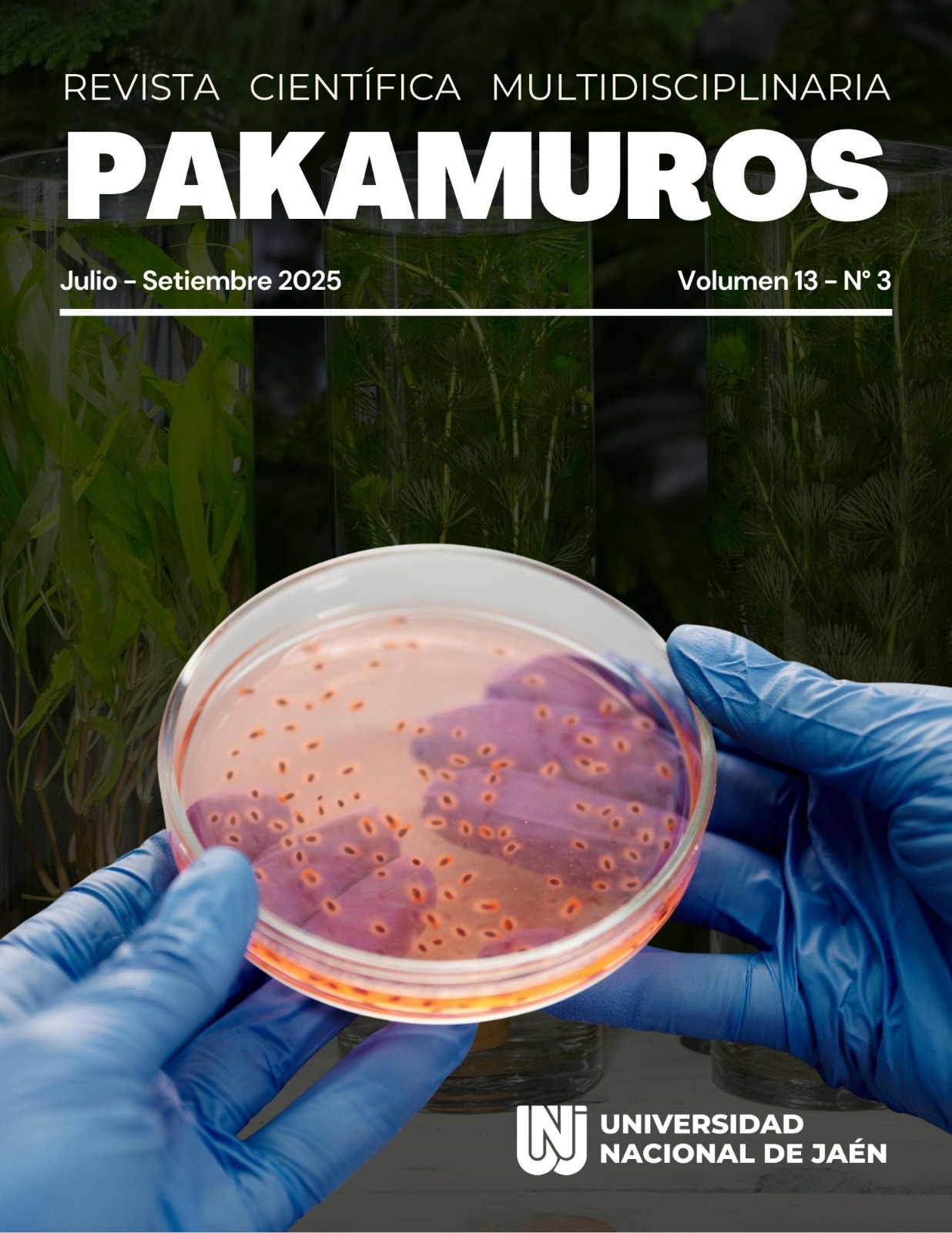Staphylococcus aureus resistente a meticilina en teléfonos de médicos y enfermeras en un hospital piurano.
DOI:
https://doi.org/10.37787/df7ver23Palabras clave:
SARM, teléfonos, personal salud, hospitalResumen
Determinar la prevalencia de contaminación por Staphylococcus aureus resistente a meticilina (SARM) en teléfonos móviles del personal de salud de un hospital de Piura, Perú. Estudio transversal que analizó 210 teléfonos móviles (92 de médicos y 118 de enfermeras). Las muestras se recolectaron mediante hisopado de superficie, sembrándose en agar manitol salado. La identificación bacteriana incluyó tinción de Gram, pruebas bioquímicas y confirmación mediante sistema automatizado. La resistencia a meticilina se determinó según guidelines CLSI 2023. El análisis estadístico incluyó pruebas de chi-cuadrado con significancia de p < 0.05. La prevalencia global de contaminación por SARM fue de 27.1%. El personal de enfermería presentó mayor prevalencia (30.5%) compared to médicos (22.8%), aunque esta diferencia no fue estadísticamente significativa (p = 0.195). Solo el 21.4% de los participantes reportó realizar limpieza diaria de sus dispositivos. Los teléfonos móviles constituyen un reservorio importante de SARM en el ambiente hospitalario, especialmente entre el personal de enfermería. Los resultados destacan la necesidad crítica de implementar protocolos de desinfección periódica y reforzar las medidas de higiene de manos, particularmente en grupos de mayor exposición. Se recomienda la implementación de programas educativos continuos y futuras investigaciones con caracterización molecular de cepas.
Referencias
Adhikari, P., Basyal, D., Rai, J. R., Bharati, L., Budthapa, A., Gharti, K. P., & Sah, S. K. (2023). Prevalence, antimicrobial susceptibility pattern and multidrug resistance of methicillin-resistant Staphylococcus aureus isolated from clinical samples at a tertiary care teaching hospital: an observational, cross-sectional study from the Himalayan country, Nepal. BMJ Open, 13(5), e067384. https://doi.org/10.1136/BMJOPEN-2022-067384
Albastaki, A., Olsen, M., Almulla, H., Nassar, R., Boucherabine, S., Mohamed, L., Almheiri, R., Kachigunda, B., McKirdy, S., Alghafri, R., Tajouri, L., & Senok, A. (2023). Mobile phones as fomites for pathogenic microbes: A cross-sectional survey of perceptions and sanitization habits of health care workers in Dubai, United Arab Emirates. Infection, Disease & Health, 28(1), 19–26. https://doi.org/10.1016/J.IDH.2022.07.001
Brady, R. R. W., Verran, J., Damani, N. N., & Gibb, A. P. (2009). Review of mobile communication devices as potential reservoirs of nosocomial pathogens. Journal of Hospital Infection, 71(4), 295–300. https://doi.org/10.1016/j.jhin.2008.12.009
Chang, Q., Wang, W., Regev-Yochay, G., Lipsitch, M., & Hanage, W. P. (2014). Antibiotics in agriculture and the risk to human health: how worried should we be? Evolutionary Applications, 8(3), 240. https://doi.org/10.1111/EVA.12185
Halatoko, W. A., Bidjada, B., Sopoh, G. E., Kpaïkpaï, P., Bara, F. D., Akpanta, K., Issa, Z., Akolly, K., Sadji, Y. A., Katawa, G., Salou, M., Karou, S. D., Ouendo, E. M., Halatoko, W. A., Bidjada, B., Sopoh, G. E., Kpaïkpaï, P., Bara, F. D., Akpanta, K., … Ouendo, E. M. (2023). Effectiveness of Disinfection in Bacteriology Laboratories in Togo, 2021. Open Journal of Preventive Medicine, 13(7), 213–226. https://doi.org/10.4236/OJPM.2023.137014
Hamdan-Partida, A., González-García, S., Martínez-Ruíz, F. J., Zavala-Sánchez, M. Á., Bustos-Hamdan, A., & Bustos-Martínez, J. (2022). Molecular Characterization of Staphylococcus aureus Strains Isolated from Mobile Phones. Microorganisms, 10(3). https://doi.org/10.3390/MICROORGANISMS10030669,
Kopp, J., Cawcutt, K. A., Musil, L., Huang, X., Minard, C. G., & Hetland, B. (2023). Efficacy of a bioburden reduction intervention on mobile phones of critical care nurses. American Journal of Infection Control, 51(1), 35–40. https://doi.org/10.1016/J.AJIC.2022.04.013
Kramer, A., & Assadian, O. (2014). Survival of Microorganisms on Inanimate Surfaces. Use of Biocidal Surfaces for Reduction of Healthcare Acquired Infections, 9783319080574, 7. https://doi.org/10.1007/978-3-319-08057-4_2
Lakhundi, S., & Zhang, K. (2018). Methicillin-Resistant Staphylococcus aureus: Molecular Characterization, Evolution, and Epidemiology. Clinical Microbiology Reviews, 31(4). https://doi.org/10.1128/CMR.00020-18,
Lewis, J. S., Mathers, A. J., Bobenchik, A. M., Bryson, A. L., Campeau, S., Cullen, S. K., & Dingle, T. (2024). M100Ed34 | Performance Standards for Antimicrobial Susceptibility Testing, 34th Edition. A CLSI Supplement for Global Application.
Lompo, P., Heroes, A. S., Agbobli, E., Kühne, V., Tinto, H., Affolabi, D., & Jacobs, J. (2023). Bacterial Contamination of Antiseptics, Disinfectants and Hand Hygiene Products in Healthcare Facilities in High-Income Countries: A Scoping Review. Hygiene, 3(2), 136–175. https://doi.org/10.3390/HYGIENE3020012/S1
Mouahid, S. El, El Mouahid, S., Echchakery, M., Tounsi, A., & Boussaa, S. (2024). Prevalence and Inherent factors in the bacterial contamination of the mobile phones of health workers: Literature review. Microbes and Infectious Diseases, 0(0), 0–0. https://doi.org/10.21608/MID.2024.262303.1756
Selim, H. S., & Abaza, A. F. (2015). Microbial contamination of mobile phones in a health care setting in Alexandria, Egypt. GMS Hygiene and Infection Control, 10, Doc03. https://doi.org/10.3205/DGKH000246
Smith, M. A., Mathewson, J. J., Ulert, I. A., Scerpella, E. G., & Ericsson, C. D. (1996). Contaminated stethoscopes revisited. Archives of Internal Medicine, 156(1). https://doi.org/10.1001/archinte.156.1.82
Tamayo-Contreras, H. L., Campos-Altamirano, M. S. L., Baca-Choque, Y. C., Bazán-Tanchiva, L., & Neyra-Rivera, C. D. (2021). Multirresistencia en Escherichia coli asociada a Betalactamasas de Espectro Extendido en urocultivos obtenidos en pacientes de una provincia de la Amazonía Peruana. Revista Del Cuerpo Médico Hospital Nacional Almanzor Aguinaga Asenjo, 14(4). https://doi.org/10.35434/rcmhnaaa.2021.144.1457
Ulger, F., Dilek, A., Esen, S., Sunbul, M., & Leblebicioglu, H. (2015). Are healthcare workers’ mobile phones a potential source of nosocomial infections? Review of the literature. Journal of Infection in Developing Countries, 9(10), 1046–1053. https://doi.org/10.3855/JIDC.6104
Weterings, V., Kievits, H., Rijen, M. van, & Kluytmans, J. (2020). Methicillin-Resistant Staphylococcus aureus Prevalence Among Healthcare Workers in Contact Tracings in a Dutch Hospital. Infection Control & Hospital Epidemiology, 41(S1), s316–s317. https://doi.org/10.1017/ICE.2020.910
Publicado
Número
Sección
Licencia
Derechos de autor 2025 Revista Científica Pakamuros

Esta obra está bajo una licencia internacional Creative Commons Atribución-NoComercial 4.0.












